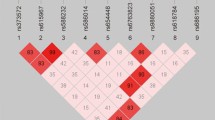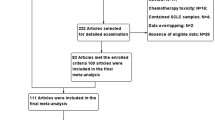Abstract
Purpose
Lung cancer is the leading cause of cancer deaths in the world. The toxicity of platinum-based chemotherapy is a main reason limiting its clinical effects. RAC1, as a member of the Rho family of small guanosine triphosphatases (GTPases), was reported to be related to most cancers, such as breast cancer, gastric cancer, testicular germ cell cancer, and lung cancer. Its potential of becoming a drug target in cancer treatment has been investigated in recent years. The aim of this study was to investigate the association between genetic polymorphisms and platinum-based chemotherapy toxicity.
Methods
We enrolled 317 lung cancer patients randomly. Nineteen polymorphisms of HSP genes and Rho family genes were genotyped by Sequenom MassARRAY. The logistic regression was performed by PLINK to compare the relevance of polymorphisms and toxicity outcome.
Results
We found that the polymorphisms of RAC1 rs836554, rs4720672, and rs12536544 were significantly associated with platinum-based chemotherapy toxicity (p = 0.018, p = 0.044, and p = 0.021, respectively).
Conclusions
RAC1 rs836554, rs4720672, and rs12536544 polymorphisms may be novel and useful genetic markers to predict the toxicity induced by platinum-based chemotherapy in lung cancer patients.



Similar content being viewed by others
References
Siegel RL, Miller KD, Jemal A (2015) Cancer statistics, 2015. CA Cancer J Clin 65(1):5–29
Zhang T, Li J, Xia T, Zhang N, Zhang Y, Zhao J (2015) Association between COX-2 polymorphisms and non-small cell lung cancer susceptibility. Int J Clin Exp Pathol 8(3):3168–3173
Boolell V, Alamgeer M, Watkins DN, Ganju V (2015) The evolution of therapies in non-small cell lung cancer. Cancers 7(3):1815–1846
Cortes-Funes H, Martin C, Abratt R, Lund B (1997) Safety profile of gemcitabine, a novel anticancer agent, in non-small cell lung cancer. Anticancer Drugs 8(6):582–587
Han B, Guo Z, Ma Y, Kang S, Wang Y, Wei Q, Wu X (2015) Association of GSTP1 and XRCC1 gene polymorphisms with clinical outcome of advanced non-small cell lung cancer patients with cisplatin-based chemotherapy. Int J Clin Exp Pathol 8(4):4113–4119
Xu X, Han L, Duan L, Zhao Y, Yang H, Zhou B, Ma R, Yuan R, Zhou H, Liu Z (2013) Association between eIF3alpha polymorphism and severe toxicity caused by platinum-based chemotherapy in non-small cell lung cancer patients. Br J Clin Pharmacol 75(2):516–523
Chen J, Yin J, Li X, Wang Y, Zheng Y, Qian C, Xiao L, Zou T, Wang Z, Liu J, Zhang W, Zhou H, Liu Z (2014) WISP1 polymorphisms contribute to platinum-based chemotherapy toxicity in lung cancer patients. Int J Mol Sci 15(11):21011–21027
Chen J, Wu L, Wang Y, Yin J, Li X, Wang Z, Li H, Zou T, Qian C, Li C, Zhang W, Zhou H, Liu Z (2015) Effect of transporter and DNA repair gene polymorphisms to lung cancer chemotherapy toxicity. Tumour Biol 37(2):2275–2284
Aslan JE, McCarty OJ (2013) Rho GTPases in platelet function. J Throm Haemost JTH 11(1):35–46
Chi X, Wang S, Huang Y, Stamnes M, Chen JL (2013) Roles of rho GTPases in intracellular transport and cellular transformation. Int J Mol Sci 14(4):7089–7108
Marinkovic G, Heemskerk N, van Buul JD, de Waard V (2015) The ins and outs of small GTPase Rac1 in the vasculature. J Pharmacol Exp Ther 354(2):91–102
Matos P, Skaug J, Marques B, Beck S, Verissimo F, Gespach C, Boavida MG, Scherer SW, Jordan P (2000) Small GTPase Rac1: structure, localization, and expression of the human gene. Biochem Biophys Res Commun 277(3):741–751
Sundaram S (2015) Rac1 is a novel interactor of drosophila guanine nucleotide exchange factor GEFmeso. Mol Cell Biochem 404(1–2):259–262
Bid HK, Roberts RD, Manchanda PK, Houghton PJ (2013) RAC1: an emerging therapeutic option for targeting cancer angiogenesis and metastasis. Mol Cancer Ther 12(10):1925–1934
Chen QY, Xu LQ, Jiao DM, Yao QH, Wang YY, Hu HZ, Wu YQ, Song J, Yan J, Wu LJ (2011) Silencing of Rac1 modifies lung cancer cell migration, invasion and actin cytoskeleton rearrangements and enhances chemosensitivity to antitumor drugs. Int J Mol Med 28(5):769–776
Nahleh Z, Tfayli A, Najm A, El Sayed A, Nahle Z (2012) Heat shock proteins in cancer: targeting the ‘chaperones’. Future Med Chem 4(7):927–935
Kaigorodova EV, Bogatyuk MV (2014) Heat shock proteins as prognostic markers of cancer. Curr Cancer Drug Targets 14(8):713–726
Calderwood SK, Gong J (2016) Heat shock proteins promote cancer: it’s a protection racket. Trends Biochem Sci 41(4):311–323. doi:10.1016/j.tibs.2016.01.003
Sankhala KK, Mita MM, Mita AC, Takimoto CH (2011) Heat shock proteins: a potential anticancer target. Curr Drug Targets 12(14):2001–2008
Shinozuka K, Tang H, Jones RB, Li D, Nieto Y (2015) Impact of polymorphic variations of gemcitabine metabolism, DNA damage repair, and drug-resistance genes on the effect of high-dose chemotherapy for relapsed or refractory lymphoid malignancies. Biol Blood Marrow Transplant 22(5):843–849
Aznar S, Lacal JC (2001) Rho signals to cell growth and apoptosis. Cancer Lett 165(1):1–10
Hodis E, Watson IR, Kryukov GV, Arold ST, Imielinski M, Theurillat JP, Nickerson E, Auclair D, Li L, Place C, Dicara D, Ramos AH, Lawrence MS, Cibulskis K, Sivachenko A, Voet D, Saksena G, Stransky N, Onofrio RC, Winckler W, Ardlie K, Wagle N, Wargo J, Chong K, Morton DL, Stemke-Hale K, Chen G, Noble M, Meyerson M, Ladbury JE, Davies MA, Gershenwald JE, Wagner SN, Hoon DS, Schadendorf D, Lander ES, Gabriel SB, Getz G, Garraway LA, Chin L (2012) A landscape of driver mutations in melanoma. Cell 150(2):251–263
Krauthammer M, Kong Y, Ha BH, Evans P, Bacchiocchi A, McCusker JP, Cheng E, Davis MJ, Goh G, Choi M, Ariyan S, Narayan D, Dutton-Regester K, Capatana A, Holman EC, Bosenberg M, Sznol M, Kluger HM, Brash DE, Stern DF, Materin MA, Lo RS, Mane S, Ma S, Kidd KK, Hayward NK, Lifton RP, Schlessinger J, Boggon TJ, Halaban R (2012) Exome sequencing identifies recurrent somatic RAC1 mutations in melanoma. Nat Genet 44(9):1006–1014
Alan JK, Lundquist EA (2013) Mutationally activated Rho GTPases in cancer. Small GTPases 4(3):159–163
Bourgine J, Garat A, Allorge D, Crunelle-Thibaut A, Lo-Guidice JM, Colombel JF, Broly F, Billaut-Laden I (2011) Evidence for a functional genetic polymorphism of the Rho-GTPase Rac1. Implication in azathioprine response? Pharmacogenet Genomics 21(6):313–324
Szondy K, Rusai K, Szabo AJ, Nagy A, Gal K, Fekete A, Kovats Z, Losonczy G, Lukacsovits J, Muller V (2012) Tumor cell expression of heat shock protein (HSP) 72 is influenced by HSP72 [HSPA1B A(1267)G] polymorphism and predicts survival in small Cell lung cancer (SCLC) patients. Cancer Invest 30(4):317–322
Purcell S, Neale B, Todd-Brown K, Thomas L, Ferreira MA, Bender D, Maller J, Sklar P, de Bakker PI, Daly MJ, Sham PC (2007) PLINK: a tool set for whole-genome association and population-based linkage analyses. Am J Hum Genet 81(3):559–575
Fortin Ensign SP, Mathews IT, Symons MH, Berens ME, Tran NL (2013) Implications of Rho GTPase signaling in glioma cell invasion and tumor progression. Front Oncol 3:241
Loirand G, Pacaud P (2014) Involvement of Rho GTPases and their regulators in the pathogenesis of hypertension. Small GTPases 5(4):1–10
Barrows D, Schoenfeld SM, Hodakoski C, Silkov A, Honig B, Couvillon A, Shymanets A, Nuernberg B, Asara JM, Parsons R (2015) PAK kinases mediate the phosphorylation of PREX2 to initiate feedback inhibition of Rac1. J Biol Chem 290(48):28915–28931
Lane J, Martin T, Weeks HP, Jiang WG (2014) Structure and role of WASP and WAVE in Rho GTPase signalling in cancer. Cancer Genomics Proteomics 11(3):155–165
Alvarez DE, Agaisse H (2015) A role for the small GTPase Rac1 in vaccinia actin-based motility. Small GTPases 6(2):119–122
Rassool FV, Gaymes TJ, Omidvar N, Brady N, Beurlet S, Pla M, Reboul M, Lea N, Chomienne C, Thomas NS, Mufti GJ, Padua RA (2007) Reactive oxygen species, DNA damage, and error-prone repair: a model for genomic instability with progression in myeloid leukemia? Cancer Res 67(18):8762–8771
Sallmyr A, Fan J, Datta K, Kim KT, Grosu D, Shapiro P, Small D, Rassool F (2008) Internal tandem duplication of FLT3 (FLT3/ITD) induces increased ROS production, DNA damage, and misrepair: implications for poor prognosis in AML. Blood 111(6):3173–3182
Ong CC, Gierke S, Pitt C, Sagolla M, Cheng CK, Zhou W, Jubb AM, Strickland L, Schmidt M, Duron SG, Campbell DA, Zheng W, Dehdashti S, Shen M, Yang N, Behnke ML, Huang W, McKew JC, Chernoff J, Forrest WF, Haverty PM, Chin SF, Rakha EA, Green AR, Ellis IO, Caldas C, O’Brien T, Friedman LS, Koeppen H, Rudolph J, Hoeflich KP (2015) Small molecule inhibition of group I p21-activated kinases in breast cancer induces apoptosis and potentiates the activity of microtubule stabilizing agents. Breast Cancer Res BCR 17:59
Jamieson C, Lui C, Brocardo MG, Martino-Echarri E, Henderson BR (2015) Rac1 augments Wnt signaling by stimulating beta-catenin-lymphoid enhancer factor-1 complex assembly independent of beta-catenin nuclear import. J Cell Sci 128(21):3933–3946
Schnelzer A, Prechtel D, Knaus U, Dehne K, Gerhard M, Graeff H, Harbeck N, Schmitt M, Lengyel E (2000) Rac1 in human breast cancer: overexpression, mutation analysis, and characterization of a new isoform, Rac1b. Oncogene 19(26):3013–3020
Hsu KL, Tsuboi K, Adibekian A, Pugh H, Masuda K, Cravatt BF (2012) DAGLbeta inhibition perturbs a lipid network involved in macrophage inflammatory responses. Nat Chem Biol 8(12):999–1007
Oudin MJ, Hobbs C, Doherty P (2011) DAGL-dependent endocannabinoid signalling: roles in axonal pathfinding, synaptic plasticity and adult neurogenesis. Eur J Neurosci 34(10):1634–1646
Tapia-Castillo A, Carvajal CA, Campino C, Vecchiola A, Allende F, Solari S, Garcia L, Lavanderos S, Valdivia C, Fuentes C, Lagos CF, Martinez-Aguayo A, Baudrand R, Aglony M, Garcia H, Fardella CE (2014) Polymorphisms in the RAC1 gene are associated with hypertension risk factors in a Chilean pediatric population. Am J Hypertens 27(3):299–307
Acknowledgments
This work was supported by the National High-tech R&D Program of China (863 Program) (2012AA02A517), National Natural Science Foundation of China (81373490, 81573508, 81573463), Hunan Provincial Science and Technology Plan of China (2015TP1043), and Open Foundation of Innovative Platform in University of Hunan Province of China (2015-14).
Author information
Authors and Affiliations
Corresponding author
Ethics declarations
Conflict of interest
The authors declare that they have no conflict of interest.
Ethical approval
All procedures performed in studies involving human participants were in accordance with the ethical standards of the institutional research committee and with the 1964 Helsinki Declaration and its later amendments or comparable ethical standards.
Informed consent
Informed consent was obtained from all individual participants included in the study.
Electronic supplementary material
Below is the link to the electronic supplementary material.
Rights and permissions
About this article
Cite this article
Zou, T., Yin, J., Zheng, W. et al. Rho GTPases: RAC1 polymorphisms affected platinum-based chemotherapy toxicity in lung cancer patients. Cancer Chemother Pharmacol 78, 249–258 (2016). https://doi.org/10.1007/s00280-016-3072-0
Received:
Accepted:
Published:
Issue Date:
DOI: https://doi.org/10.1007/s00280-016-3072-0




